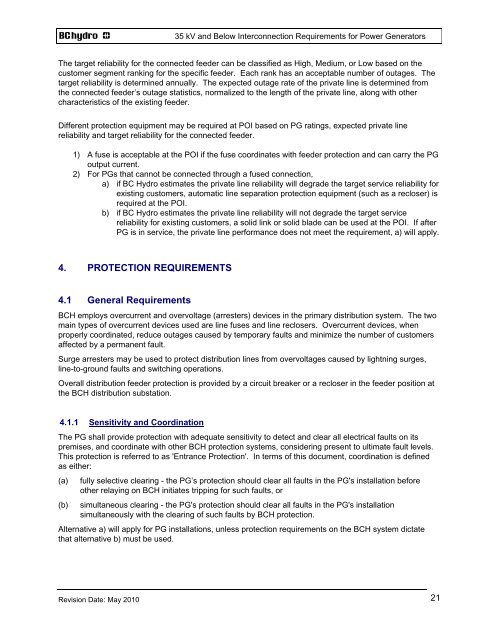35 kV and Below INTERCONNECTION REQUIREMENTS - BC Hydro
35 kV and Below INTERCONNECTION REQUIREMENTS - BC Hydro
35 kV and Below INTERCONNECTION REQUIREMENTS - BC Hydro
You also want an ePaper? Increase the reach of your titles
YUMPU automatically turns print PDFs into web optimized ePapers that Google loves.
Revision Date: May 2010<br />
<strong>35</strong> <strong>kV</strong> <strong>and</strong> <strong>Below</strong> Interconnection Requirements for Power Generators<br />
The target reliability for the connected feeder can be classified as High, Medium, or Low based on the<br />
customer segment ranking for the specific feeder. Each rank has an acceptable number of outages. The<br />
target reliability is determined annually. The expected outage rate of the private line is determined from<br />
the connected feeder’s outage statistics, normalized to the length of the private line, along with other<br />
characteristics of the existing feeder.<br />
Different protection equipment may be required at POI based on PG ratings, expected private line<br />
reliability <strong>and</strong> target reliability for the connected feeder.<br />
1) A fuse is acceptable at the POI if the fuse coordinates with feeder protection <strong>and</strong> can carry the PG<br />
output current.<br />
2) For PGs that cannot be connected through a fused connection,<br />
a) if <strong>BC</strong> <strong>Hydro</strong> estimates the private line reliability will degrade the target service reliability for<br />
existing customers, automatic line separation protection equipment (such as a recloser) is<br />
required at the POI.<br />
b) if <strong>BC</strong> <strong>Hydro</strong> estimates the private line reliability will not degrade the target service<br />
reliability for existing customers, a solid link or solid blade can be used at the POI. If after<br />
PG is in service, the private line performance does not meet the requirement, a) will apply.<br />
4. PROTECTION <strong>REQUIREMENTS</strong><br />
4.1 General Requirements<br />
<strong>BC</strong>H employs overcurrent <strong>and</strong> overvoltage (arresters) devices in the primary distribution system. The two<br />
main types of overcurrent devices used are line fuses <strong>and</strong> line reclosers. Overcurrent devices, when<br />
properly coordinated, reduce outages caused by temporary faults <strong>and</strong> minimize the number of customers<br />
affected by a permanent fault.<br />
Surge arresters may be used to protect distribution lines from overvoltages caused by lightning surges,<br />
line-to-ground faults <strong>and</strong> switching operations.<br />
Overall distribution feeder protection is provided by a circuit breaker or a recloser in the feeder position at<br />
the <strong>BC</strong>H distribution substation.<br />
4.1.1 Sensitivity <strong>and</strong> Coordination<br />
The PG shall provide protection with adequate sensitivity to detect <strong>and</strong> clear all electrical faults on its<br />
premises, <strong>and</strong> coordinate with other <strong>BC</strong>H protection systems, considering present to ultimate fault levels.<br />
This protection is referred to as 'Entrance Protection'. In terms of this document, coordination is defined<br />
as either:<br />
(a) fully selective clearing - the PG’s protection should clear all faults in the PG's installation before<br />
other relaying on <strong>BC</strong>H initiates tripping for such faults, or<br />
(b) simultaneous clearing - the PG's protection should clear all faults in the PG's installation<br />
simultaneously with the clearing of such faults by <strong>BC</strong>H protection.<br />
Alternative a) will apply for PG installations, unless protection requirements on the <strong>BC</strong>H system dictate<br />
that alternative b) must be used.<br />
21
















